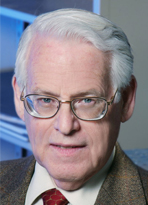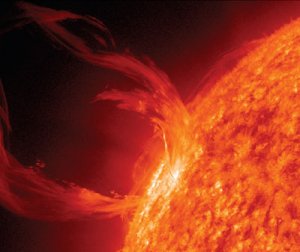“Making the Invisible Sun Visible” Topic of March 27 Sturm Lecture

Almost all light from the Sun is the visible light that illuminates our days, but human eyes cannot detect the light from the million-degree Solar Corona, which is at short wavelengths.
On March 27 during the 21st annual Sturm Memorial Lecture, solar physicist Alan Title will describe the instrumentation he has helped develop to make the invisible Sun visible and how this has revolutionized our understanding of the Sun. His talk is titled “Making the Invisible Sun Visible.”
The Sturm Memorial Lecture is held in memory of Kenneth E. Sturm ’40. The annual event features a presentation from an astronomer that is outstanding in their field and able to communicate the excitement of science to a lay audience. Title’s lecture begins at 8 p.m. in Daniel Family Commons.
Title is a leader in solar physics and principal investigator of the imager on NASA’s recently launched Solar Dynamics Observatory, an $850-million mission to study the Sun and its influence on the Earth. He works as the director and senior fellow of the Advanced Technology Center at Lockheed Martin, and as a professor of physics at Stanford University.
Title has received numerous awards, including membership in the National Academy of Sciences, the Hale Prize from the American Astronomical Society, a NASA Public Service Award and most recently the American Geophysical Union’s John Adam Fleming Medal for “original research and technical leadership in geomagnetism, atmospheric electricity, aeronomy, space physics, and related sciences.” His work on the magnetic structure of the Sun has been enabled by his groundbreaking designs of instruments that have flown on several generations of space missions.
Among his many scientific contributions, Title invented the term “magnetic carpet” to describe the multitude of dynamic magnetic connections in the solar atmosphere that drive the solar corona and are imprinted in the solar wind. He stimulated feature tracking to map the solar surface flows as they carry around the magnetic field.

“We are very excited to have a high profile scientist as this year’s Sturm Lecturer,” says Seth Redfield, assistant professor of astronomy. “Dr. Title’s imaging camera on the Solar Dynamics Observatory provides continuous and amazing images of the Sun. If you have seen a recent image of the Sun, including any of the solar flares that occurred earlier this month, they were almost certainly from his instrument.”
In addition to the lecture, the Astronomy Department will host public outreach events, including solar observations through telescopes set up on Foss Hill all day on Tuesday, and night sky observations after the public lecture.
Past Sturm Memorial Lecture speakers include Nobel Laureate John Mather of the NASA Goddard Space Flight Center; Alyssa Goodman of the Harvard-Smithsonian Center for Astrophysics and Jill Tarter of the SETI Institute.
The event is sponsored by the Astronomy Department and the Allbritton Center for the Study of Public Life. For more information, see the event’s poster.

